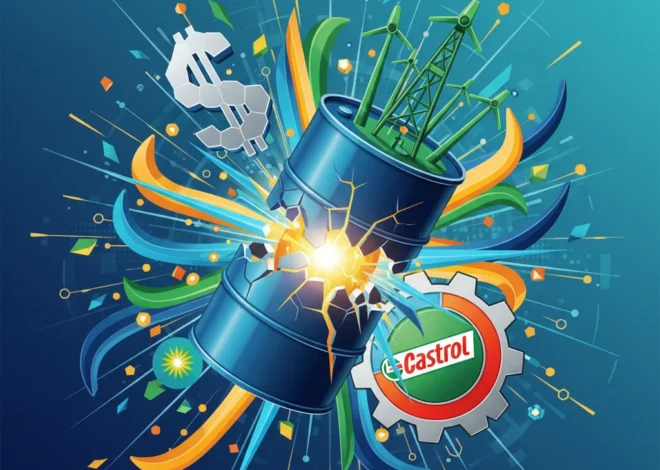
Nuclear Ambition: Can EDF’s High-Stakes Bet on Sizewell C Reboot Its Fortunes and Secure Europe’s Energy Future?
In the high-stakes world of global energy, few sectors carry the financial weight and geopolitical significance of nuclear power. Amid a global push for energy security and decarbonization, France’s state-owned energy giant, EDF, is at a critical juncture. Led by its chief executive, Luc Rémont, the company has made a bold declaration: it will accelerate its nuclear projects, aiming to close a performance gap with its faster, more efficient Asian counterparts that has become both an economic liability and a source of national embarrassment. The chosen battleground for this ambitious turnaround is Sizewell C, a planned multi-billion-pound nuclear power station on the UK coast, which EDF intends to use as a global showcase of its revitalized capabilities.
For decades, EDF was the poster child for nuclear excellence. But recent history has been marred by colossal budget overruns and debilitating delays on its flagship projects. This track record has not only damaged its reputation but has also cast a long shadow over the economic viability of new nuclear builds in the West. Now, as Europe grapples with a volatile energy market and an urgent need to shore up its industrial base, Rémont’s vow is more than just a corporate strategy; it’s a crucial test of whether the continent can still execute mega-projects on a global scale. The outcome will have profound implications for the future of the energy `economy`, long-term `investing` strategies, and the very fabric of European energy independence.
The Heavy Legacy of Delays: A Crisis of Confidence
To understand the magnitude of EDF’s challenge, one must look at its recent project history. The company’s signature EPR (European Pressurised Reactor) technology, designed to be one of the safest and most efficient in the world, has become synonymous with financial and logistical quagmires. The Flamanville 3 project in Normandy, France, is a case in point. Originally slated for completion in 2012 at a cost of €3.3 billion, it is now more than a decade behind schedule with costs spiraling to over €13.2 billion (source).
Similarly, Hinkley Point C in the UK, the first new nuclear plant to be built in the country for a generation, has faced its own severe headwinds. Its projected cost has ballooned from an initial £18 billion to a current estimate of up to £35 billion, with significant delays pushing its operational start date further into the future. These are not minor miscalculations; they represent a systemic failure in project management and supply chain coordination that has shaken confidence across the `finance` and `investing` communities. Each delay adds billions in financing costs and postpones the delivery of vital, low-carbon electricity, impacting everything from national energy policy to the `stock market` performance of supply chain partners.
The Asian Benchmark: A Tale of Two Nuclear Models
A key driver of EDF’s strategic pivot is the stark contrast with its peers in Asia. While Western nuclear projects have faltered, countries like South Korea and China have been building reactors on time and on budget with remarkable consistency. Their success stems from a fundamentally different approach to nuclear construction, one rooted in standardization and a continuous, state-supported industrial strategy.
Companies like South Korea’s KEPCO have perfected a “fleet approach,” constructing multiple identical reactors in succession. This creates immense efficiencies, retains a highly skilled workforce, and streamlines the supply chain. This industrial model treats nuclear reactors less like unique architectural marvels and more like sophisticated, manufactured products. The data paints a clear picture of this performance gap.
Below is a comparative look at recent nuclear project timelines, highlighting the challenge EDF faces.
| Project | Country | Reactor Type | Construction Start | Grid Connection | Approx. Duration |
|---|---|---|---|---|---|
| Flamanville 3 | France | EPR | Dec 2007 | Est. Mid-2024 | ~16.5 years |
| Hinkley Point C (Unit 1) | UK | EPR | Mar 2017 | Est. 2029-2031 | ~12-14 years |
| Barakah (Unit 1) | UAE (by KEPCO) | APR-1400 | Jul 2012 | Aug 2020 | ~8 years |
| Hongyanhe (Unit 5) | China | ACPR-1000 | Mar 2015 | Jun 2021 | ~6 years |
This data starkly illustrates the challenge. Asian projects are consistently completed in half the time of their European counterparts. This isn’t just about construction speed; it’s about the entire `economics` of the project. Shorter build times dramatically reduce financing costs, making the final price of electricity more competitive and the project a more attractive proposition for private `investing`.
Sizewell C: The Litmus Test for a New European Approach
This is where Sizewell C enters the picture. For EDF and Rémont, this project is the crucible where their new strategy will be forged or broken. The plan hinges on leveraging the painful lessons from Hinkley Point C. By replicating the design, EDF aims to eliminate engineering uncertainties and move directly to efficient construction. “The ambition for Sizewell is to be a clear demonstrator that this design can be built on time and on budget,” Rémont stated in an interview with the Financial Times.
The strategy involves a three-pronged attack on its past failures:
- Radical Standardization: Treating the EPR design as a finalized product, not a prototype. This means freezing the design and focusing entirely on replicating the construction process developed at Hinkley.
- Supply Chain Industrialization: Moving away from bespoke components to a more industrialized and reliable supply chain. This requires long-term partnerships and greater visibility, an area where modern `financial technology` (FinTech) solutions for supply chain finance and even `blockchain` for parts traceability could play a transformative role.
- Disciplined Project Management: Instilling a manufacturing mindset focused on repeatable processes and strict adherence to timelines and budgets, a significant cultural shift for the engineering-led organization.
The financing of Sizewell C is also a critical piece of the puzzle. The UK government has already committed £700 million and taken a 50% stake in the project’s development company (source), signaling strong state backing. The project will likely be funded through a Regulated Asset Base (RAB) model, a financing mechanism designed to lower the cost of capital by providing investors with a secure, regulated return during the construction phase. This model is crucial for attracting the vast sums of private capital needed from pension funds and infrastructure investors.
Beyond the Balance Sheet: Why Financial Literacy is the Most Critical Investment in Today's Economy
The Macro-Economic Stakes: Energy Security and Financial Stability
The success or failure of EDF’s nuclear revival extends far beyond its own balance sheet. For Europe, a reliable and scalable nuclear program is a cornerstone of achieving both energy security and its net-zero emissions targets. Nuclear power provides constant, low-carbon baseload electricity that can stabilize a grid increasingly reliant on intermittent renewables like wind and solar. In an era of geopolitical instability, reducing dependence on imported fossil fuels is a paramount objective of national `economics`.
For the financial world, a successful Sizewell C would de-risk future nuclear projects, potentially unlocking a new wave of `investing` in the sector. It would prove that Western nations can still deliver complex, critical infrastructure, boosting confidence in related sectors from advanced manufacturing to specialized engineering. A revitalized nuclear supply chain, including many publicly listed companies, would see a significant uplift, impacting the broader `stock market`. Conversely, another high-profile failure would likely be a death knell for new large-scale nuclear builds in Europe for a generation, forcing a difficult and expensive re-evaluation of the continent’s entire energy transition strategy.
Beyond the Ivory Tower: How New Rankings Are Redefining the Value of Business School Research
Ultimately, Luc Rémont is steering EDF through a high-stakes gamble. He is betting that the lessons of the past, combined with a renewed sense of urgency and a disciplined, manufacturing-inspired approach, can overcome decades of inertia. Sizewell C is not just another power plant; it is a referendum on a company, an industry, and a continent’s ability to build the future. Investors, policymakers, and citizens alike will be watching closely, as the outcome will send powerful ripples through the global energy and `finance` landscapes for years to come.


